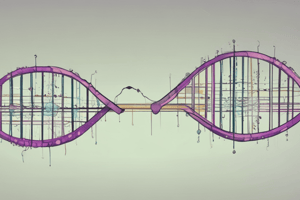Podcast
Questions and Answers
Explain how the analysis of STR loci helped determine that the suspected father is not the biological father of Child 3?
Explain how the analysis of STR loci helped determine that the suspected father is not the biological father of Child 3?
At D8, the father does not have either 10 or 15 repeat alleles. At D21, the father does not have the 30 repeat allele that the child has. Since some STRs do not come from the suspected father, another individual must be the biological father of Child 3.
How can partial DNA matches be used in crime scenes to identify close relatives of the individual?
How can partial DNA matches be used in crime scenes to identify close relatives of the individual?
Partial DNA matches in crime scenes imply that the DNA belongs to a close relative of the individual.
What does a full DNA match in crime scene analysis suggest about the likelihood of the DNA belonging to the individual?
What does a full DNA match in crime scene analysis suggest about the likelihood of the DNA belonging to the individual?
A full DNA match in crime scene analysis suggests a high likelihood that the DNA belongs to the individual.
Explain the significance of inheritance patterns in DNA profiling and parentage determination.
Explain the significance of inheritance patterns in DNA profiling and parentage determination.
How does the analysis of specific alleles at STR loci contribute to determining the biological father of a child?
How does the analysis of specific alleles at STR loci contribute to determining the biological father of a child?
Why is it important to analyze multiple STR loci in DNA profiling for parentage determination?
Why is it important to analyze multiple STR loci in DNA profiling for parentage determination?
What are the steps involved in generating and analyzing a DNA gel for a paternity case?
What are the steps involved in generating and analyzing a DNA gel for a paternity case?
How can DNA bands from the child be matched with those of potential fathers in a paternity case?
How can DNA bands from the child be matched with those of potential fathers in a paternity case?
In paternity testing, why is it important to match the child's DNA bands with those of potential fathers?
In paternity testing, why is it important to match the child's DNA bands with those of potential fathers?
How can colors be used in DNA gel analysis for matching the child's bands with the correct father's band?
How can colors be used in DNA gel analysis for matching the child's bands with the correct father's band?
Explain how a similar technique used in paternity testing can be applied in forensic cases.
Explain how a similar technique used in paternity testing can be applied in forensic cases.
What is the significance of obtaining partial or complete matches in DNA profiling at crime scenes?
What is the significance of obtaining partial or complete matches in DNA profiling at crime scenes?
Identify which parent each marker came from for Child 1, 2, and 3 at STR locus D3.
Identify which parent each marker came from for Child 1, 2, and 3 at STR locus D3.
What conclusion can you draw about Child 3? Provide evidence for your response.
What conclusion can you draw about Child 3? Provide evidence for your response.
Explain the process of determining the biological father using STR loci analysis.
Explain the process of determining the biological father using STR loci analysis.
How can partial DNA matches be useful in crime scenes?
How can partial DNA matches be useful in crime scenes?
Discuss the significance of DNA profiling in crime scenes.
Discuss the significance of DNA profiling in crime scenes.
Explain the concept of parental DNA inheritance in the context of genetic analysis.
Explain the concept of parental DNA inheritance in the context of genetic analysis.
Flashcards are hidden until you start studying
Study Notes
Paternity Testing
- Identify an unknown child by identifying DNA bands (size and location) from the mother that appears in the child's DNA profile.
- Match the remaining bands with one of the unknown samples from different male possibilities.
- 50% of the DNA inherited in the child comes from the mother and 50% from the father.
- Remaining bands should match with the unknown father's sample.
- Colours can be used to match the child's remaining bands to the correct father's band.
DNA Manipulation Techniques and Applications
- Individuals can have large variations in STRs across various sites.
- STR profiles can be used to identify which parent each marker came from.
Analyzing STRs
- Examine each child individually at STR locus D3.
- Identify which parent each marker came from for Child 1, 2, and 3 at STR locus D3.
- Draw conclusions about Child 3 based on the STR profiles.
STRs in Crime Scenes
- DNA identified through STRs may be a full or partial match in crime scenes.
- A full match suggests a high likelihood that the DNA belongs to that individual.
- Partial matches imply that the DNA belongs to a close relative.
Studying That Suits You
Use AI to generate personalized quizzes and flashcards to suit your learning preferences.




